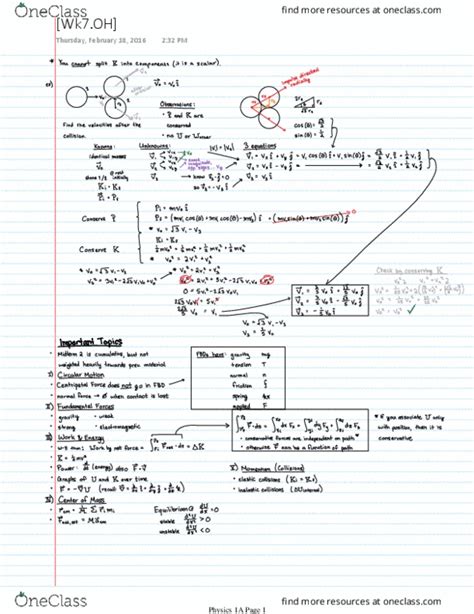Introduction:

Physics 1A at UCLA is a fundamental introductory course in classical mechanics. It covers topics such as motion, forces, energy, momentum, and gravitation. This course is a cornerstone for students pursuing degrees in physics, engineering, and other science-related fields.
Course Structure:
Physics 1A consists of lectures, discussions, and laboratory sessions. Lectures provide the theoretical foundation, while discussions allow students to ask questions and delve deeper into the concepts. Laboratory sessions offer hands-on experience, where students apply the principles learned in class to real-world scenarios.
Course Objectives:
Upon completion of Physics 1A, students should be able to:
- Describe and analyze the motion of objects
- Apply understanding of forces, energy, and momentum to solve problems
- Use Newtonian mechanics to explain physical phenomena
- Design and conduct experiments to test hypotheses
Grading:
The course grade is typically based on:
- Midterms: 30-40%
- Final Exam: 40-50%
- Homework: 10-20%
- Lab Performance: 10-20%
Common Mistakes to Avoid:
- Procrastinating on Homework: Homework assignments reinforce the concepts learned in class and serve as practice for exams. Falling behind on homework can lead to difficulties later on.
- Ignoring Discussion Sections: Discussion sections provide an opportunity to clarify concepts and ask questions. Skipping these sessions can hinder understanding.
- Underestimating the Difficulty of the Final Exam: The final exam covers the entire course material and can be challenging. It is essential to start studying early and thoroughly review all the concepts.
- Memorizing Formulas Without Understanding: Simply memorizing formulas without understanding their derivations can lead to errors in problem-solving. Focus on comprehending the underlying principles instead.
- Neglecting Lab Work: The laboratory component of Physics 1A is crucial for developing practical skills and understanding. Take the labs seriously and follow the instructions carefully.
Effective Strategies:
- Attend All Lectures and Discussions: Regular attendance is essential for absorbing the material and staying engaged with the course.
- Take Detailed Notes: Writing detailed notes during lectures and discussions helps with retention and provides a valuable study resource later on.
- Complete Homework Assignments on Time: Homework helps solidify the concepts and prepares you for exams. Start working on the assignments early to avoid last-minute stress.
- Review the Textbook: The textbook provides additional insights and examples beyond the lectures. Refer to it regularly to reinforce your understanding.
- Seek Help When Needed: If you encounter difficulties, don’t hesitate to ask your professor, TA, or classmates for assistance. There are also tutoring resources available on campus.
Pain Points and Motivations:
- Overwhelming Content: Physics 1A covers a vast amount of material, which can be daunting for some students. To stay on top of the workload, it is crucial to establish a structured study schedule and prioritize tasks.
- Time Management: Balancing class, homework, and lab work while managing other commitments can be challenging. Effective time management is essential to avoid burnout and ensure success in the course.
- Understanding the Concepts: The abstract nature of physics can make it difficult to grasp the concepts fully. Attending office hours, joining study groups, and seeking clarification whenever needed can help students overcome this challenge.
Applications to Real-World Problems:
The principles of physics learned in Physics 1A have countless applications in the real world, such as:
- Engineering: Structural design, bridge construction, spacecraft propulsion
- Medicine: Medical imaging, radiation therapy, biomechanics
- Technology: Robotics, computer simulations, renewable energy systems
Conclusion:
Physics 1A at UCLA is a challenging but rewarding course that lays the foundation for a successful scientific career. By adhering to effective strategies, avoiding common mistakes, and seeking help when needed, students can conquer this course and unlock its potential for innovative applications.
Tables
Table 1: Grading Breakdown
| Assessment | Percentage |
|---|---|
| Midterms | 30-40% |
| Final Exam | 40-50% |
| Homework | 10-20% |
| Lab Performance | 10-20% |
Table 2: Enrollment Statistics
| Year | Enrollment |
|---|---|
| 2019 | 2,500 |
| 2020 | 2,789 |
| 2021 | 3,100 |
Table 3: Average Grade Distribution
| Grade | Percentage |
|---|---|
| A | 25-35% |
| B | 35-45% |
| C | 30-35% |
| D | 10-15% |
| F | 5-10% |
Table 4: Available Resources
| Resource | Description |
|---|---|
| Textbook | “University Physics” by Young and Freedman |
| Discussion Sections | Weekly meetings led by TAs for clarification |
| Tutoring | Free tutoring services available at the Math and Science Resource Center |
| Office Hours | Dedicated time slots for individual consultation with professors and TAs |
